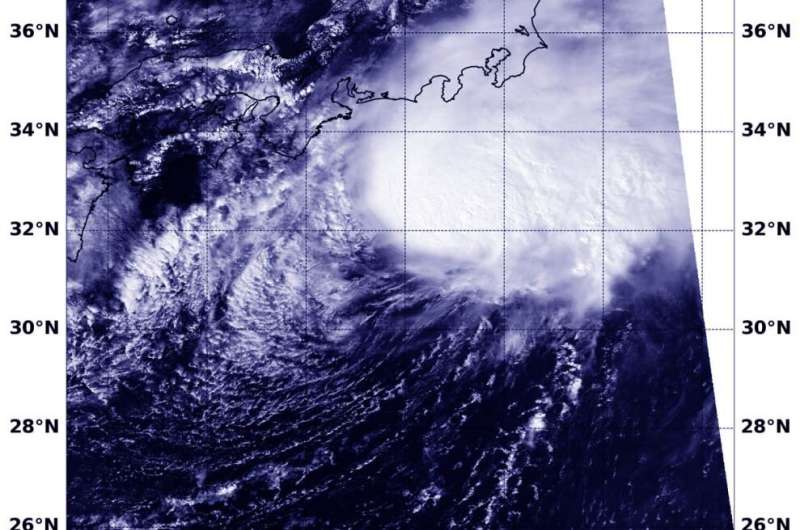NASA finds Dolphin swimming against wind shear

NASA's Terra satellite provided a visible image of a slightly elongated Tropical Storm Dolphin as it battled wind shear upon its approach to east central Japan.
A Visible Satellite Image
The Moderate Resolution Imaging Spectroradiometer or MODIS instrument that flies aboard NASA's Terra satellite captured a visible image of Tropical Storm Dolphin on Sept. 23 at 12:30 a.m. EDT (0430 UTC). Dolphin appeared somewhat elongated from west to east likely from the strong vertical wind shear the storm has been battling.
However, despite the increasing vertical wind shear of 30 knots (35 mph/56 kph), animated multispectral satellite imagery shows that Dolphin is a consolidated system with strong thunderstorms banding and wrapping into the low-level circulation center.
Wind Shear Affecting Dolphin
The shape of a tropical cyclone provides forecasters with an idea of its organization and strength. When outside winds batter a storm, it can change the storm's shape. Winds can push most of the associated clouds and rain to one side of a storm.
In general, wind shear is a measure of how the speed and direction of winds change with altitude. Tropical cyclones are like rotating cylinders of winds. Each level needs to be stacked on top each other vertically in order for the storm to maintain strength or intensify. Wind shear occurs when winds at different levels of the atmosphere push against the rotating cylinder of winds, weakening the rotation by pushing it apart at different levels.
Dolphin on Sept. 23
On Sept. 23 at 5 a.m. EDT (0900 UTC). Tropical Storm Dolphin was located near latitude 32.0 degrees north and longitude 138.6 degrees east. That is about 205 nautical miles south-southwest of Yokosuka, Japan. Dolphin was moving to the northeast and had maximum sustained winds of 50 knots (58 mph/92 kph).
Dolphin is forecast to move northeast and will gradually weaken before becoming extra-tropical near Tokyo.
NASA Researches Tropical Cyclones
Hurricanes/tropical cyclones are the most powerful weather events on Earth. NASA's expertise in space and scientific exploration contributes to essential services provided to the American people by other federal agencies, such as hurricane weather forecasting.
NASA's Terra satellite is one in a fleet of NASA satellites that provide data for hurricane research.
For more than five decades, NASA has used the vantage point of space to understand and explore our home planet, improve lives and safeguard our future. NASA brings together technology, science, and unique global Earth observations to provide societal benefits and strengthen our nation. Advancing knowledge of our home planet contributes directly to America's leadership in space and scientific exploration.
More information: For forecast updates on hurricanes, visit: www.hurricanes.gov
Provided by NASA's Goddard Space Flight Center




















